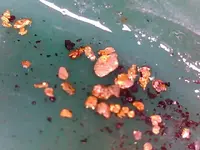Depending on how far you want to take it, you can pan over a safety tub and save the black sands including the magnetic sands. Make yourself a little rod mill as detailed here...
http://www.treasurenet.com/forums/panning-gold/456622-simple-solution-fine-gold-recovery.html and with a little more effort you can recover even a lot of the micro-fine Gold out of them.

Recovery after sluicing can be as simple or as hard as you want it to be. You can stop after you've gotten the visible gold like many others do, or you can work the sands for everything they've got. The later choice isn't that much harder, but it will take more time. For years I tossed out a lot of gold because I was only going for the visible stuff.

Now I save all the black sands (both magnetic and non magnetic) until I have enough to warrant going through them again. This will also give you something to do when the weather sucks for going out to dig in the winter months. A small investment in some fine classifiers will also make panning easier and more effective. Like sized materials separate the heavies easier than when you've got a bunch of different sizes in the pan.
Get some empty coffee cans or some other closeable containers and save your magnetic sands in one and your non magnetic sand in another. Even the magnetic sands can still have gold in them so don't just toss them out. There are other recovery methods that can be used but I won't go into them now because they require a working knowledge of lab techniques as well as some special equipment and materials that can be dangerous to work with if mishandled.




 Now I save all the black sands (both magnetic and non magnetic) until I have enough to warrant going through them again. This will also give you something to do when the weather sucks for going out to dig in the winter months. A small investment in some fine classifiers will also make panning easier and more effective. Like sized materials separate the heavies easier than when you've got a bunch of different sizes in the pan.
Now I save all the black sands (both magnetic and non magnetic) until I have enough to warrant going through them again. This will also give you something to do when the weather sucks for going out to dig in the winter months. A small investment in some fine classifiers will also make panning easier and more effective. Like sized materials separate the heavies easier than when you've got a bunch of different sizes in the pan.

